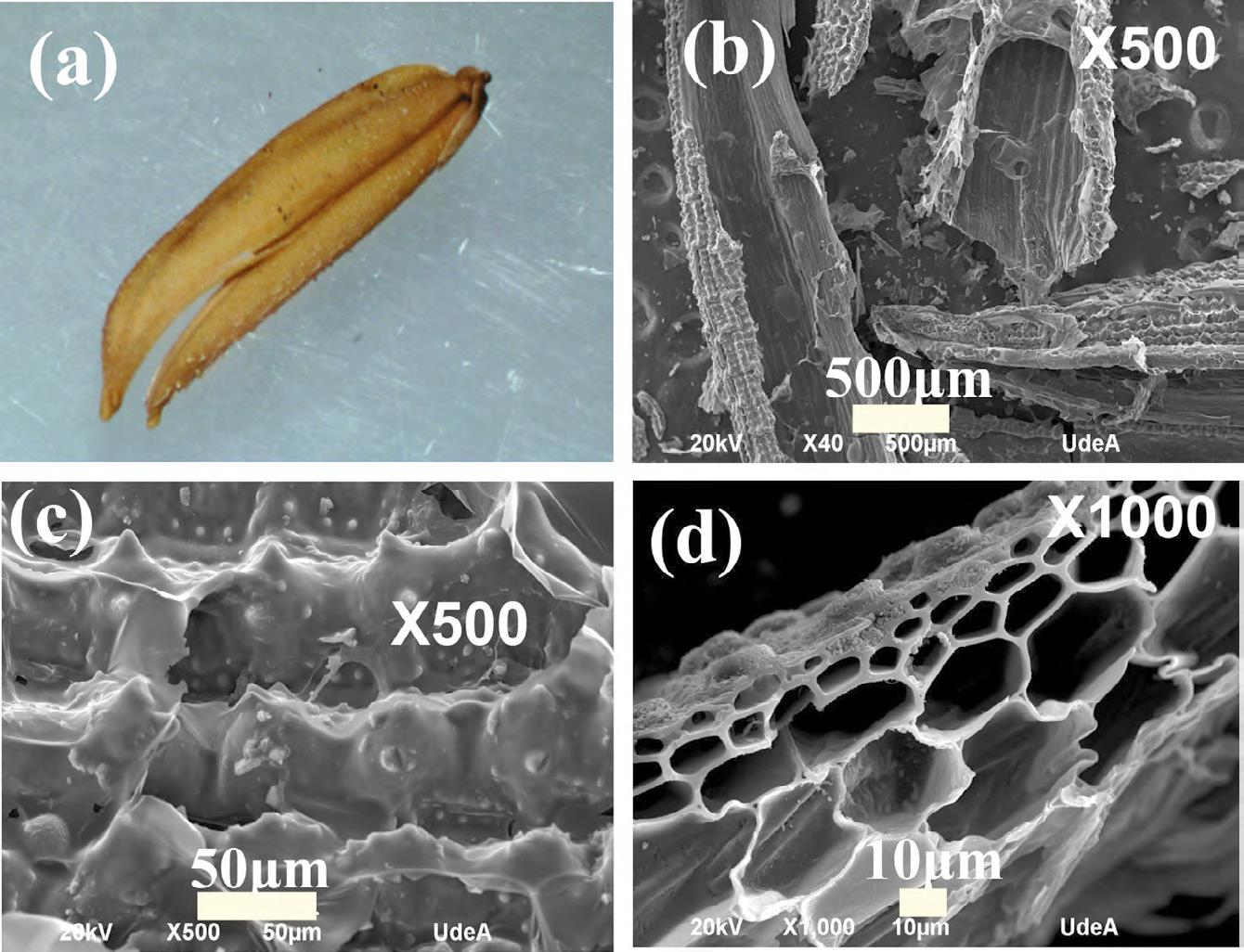Resumen
Se presenta el desarrollo y la validación de un sistema de pirolisis con atmósfera controlada de nitrógeno para la producción de material carbonoso a partir de elementos de la biomasa. El objetivo fue producir material carbonoso a partir de la cascarilla de arroz y explorar su uso en diferentes campos tecnológicos. En Colombia se producen más de 800 mil toneladas de arroz cada semestre principalmente en regiones líderes en la producción como la Orinoquia y los departamentos de Tolima y Huila. Este sistema brinda la oportunidad de utilizar residuos agroindustriales como la cascarilla de arroz que, además, afecta negativamente el medio ambiente, y convertirlo en un material útil con valor agregado para el desarrollo de la ciencia y la tecnología en campos tecnológicos emergentes. En análisis realizados mediante microscopía de barrido electrónico (SEM) se ha evidenciado que el material sintetizado es un material carbonoso y poroso compuesto por fibras irregulares con estructuras internas huecas de entre 5 y 30 μm. Los espectros Raman muestran una respuesta vibracional del tipo grafeno oxidado multicapa. Estos resultados sugieren que el grafeno oxidado derivado de la cascarilla de arroz puede ser un candidato para el desarrollo de aplicaciones tecnológicas en áreas como los dispositivos y sistemas de electrónica flexible, los sensores, las baterías, los supercapacitores para almacenamiento de energía y los sistemas de biorremediación, entre otras aplicaciones tecnológicas.
Referencias
Abril, D. & Abril, A. (2010). Silicio a partir de cáscara de arroz para la confección de paneles fotovoltaicos. UCMaule Revista Académica. 38: 11-30.
Ahiduzzaman Md, A.K.M. & Sadrull-Islam, A.K.M. (2016). Preparation of 40 porous bio-char and activated carbon from rice husk by leaching ash and chemical activation. Springer Plus. 5: 1248-1261.
Ahmad-Husni, M.H., Clasoston, N., Amran, M.S. (2014). Effects of pyrolysis temperature on the physicochemical properties of 45 empty fruit bunch and rice husk biochars. Waste Managament Research. 4 (32): 331-339.
Bharathidasan, P., Idris, M. B., Kim, D., Sivakkumar, S., Devaraj, S. (2018). Enhanced capacitance properties of nitrogen doped reduced graphene oxide obtained by simultaneous reduction and nitrogen doping. FlatChem. 11: 24-31. Doi: 10.1016/j.flatc.2018.10.001
Della, V. ., Kühn, I., & Hotza, D. (2002). Rice husk as an alternate source for active silica production. Materials Letters. 57: 818-821.
Eigler, S. & Dimiev, A.M. (2017). Characterization Techniques. In Graphene Oxide fundamentals and applications (1ª ed., pp.100-103). Ayrat M. Dimiev and Siegfried Eigler (Editors). West Sussex. Wiley.
Johra, F. T., Lee, J., Jung, W. (2014). Facile and safe graphene preparation on solution-based platform. Journal of Industrial and Engineering Chemistry. 20 (5): 2883-2887. Doi: 10.1016/j.jiec.2013.11.022
Lozano, C. (2020). Alternativa de usos de la cascarilla de arroz (Oriza sativa) en Colombia para el mejoramiento del sector productivo y la industria, tesis de prerado, Universidad Nacional Abierta y a Distancia (UNAD), Yopal - Casanare, p 32. https://doi.org/10.1017CBO9781107415324.004
Olimex. Technical Data MQ-135 Gas Sensor. (2017). Accessed on: August, 2017. Availableat: https://www.olimex.com/Products/Components/Sensors/SNSMQ135/resources/SNS-MQ135.pdf
Prasad, R. & Pandey, M. (2012). Rice husk ash as a renewable source for the production of valueadded silica gel and its applications: An overview. Bulletin of Chemical Reaction Engineering & Catalysis. 7 (1): 1-25.
Prías Barragán, J., Rojas González, C., Echeverry Montoya, N., Fonthal, G., & Ariza Calderón, H. (2011). Identificación de las variables óptimas para la obtención de carbón activado a partir del precursor guadua Angustifolia kunt. Revista Academia Colombiana de Ciencias. 25 (135): 157-166.
Prías-Barragán, J. J., Gross, K., Ariza-Calderón, H., Prieto, P. (2015). Synthesis and vibrational response of graphite oxide platelets from bamboo for electronic applications. physica status solidi (a). 213 (1): 85-90. Doi: 10.1002/pssa.201532433
Quiceno, D. & Mosquera, M. (2010). Alternativas tecnológicas para el uso de la cascarilla de arroz como combustible. Trabajo de grado, Universidad Autónoma de Occidente.
Rockstraw, D.A., Pignali K.C., Deng, S. (2005). Silver nanoparticles from ultrasonic spray pyrolysis of aqueous silver nitrate. Aerosol Science and Technology. 39 (10): 1010-1014.
Rybarczyk, M. K., Li, Y., Qiao, M., Hu, Y., Titirici, M., Lieder, M. (2019). Hard carbon derived from rice husk as low cost negative electrodes in Na-ion batteries. Journal of Energy Chemistry. 29: 17-22. Doi: 10.1016/j.jechem.2018.01.025
Souza, C. B. de, Nakagawa, M. A., Vargas, L. R., Hilário, R. B., Impère, A. G. D., Matsushima, J. T., Quirino, S. F., Gama, A. M., Baldan, M. R., & Gonçalves, E. S. (2019). Evolution of dielectric properties of thermally reduced graphene oxide as a function of pyrolisis temperature. Diamond and Related Materials. 93: 241-251. Doi: 10.1016/j.diamond.2019.01.015
Wang, W., Martin, J. C., Zhang, N., Ma, C., Han, A., & Sun, L. (2011). Harvesting silica nanoparticles from rice husk. Journal Nanoparticle Research. 13: 6981-6990.

Esta obra está bajo una licencia internacional Creative Commons Atribución-NoComercial-SinDerivadas 4.0.
Derechos de autor 2020 Revista de la Academia Colombiana de Ciencias Exactas, Físicas y Naturales


